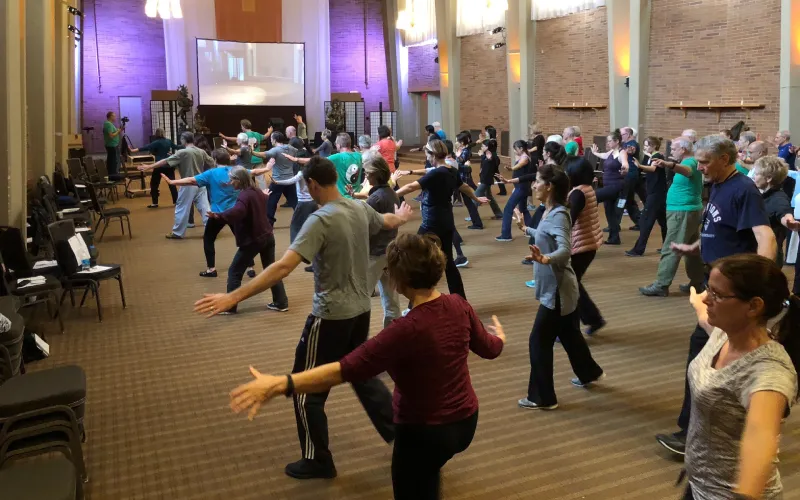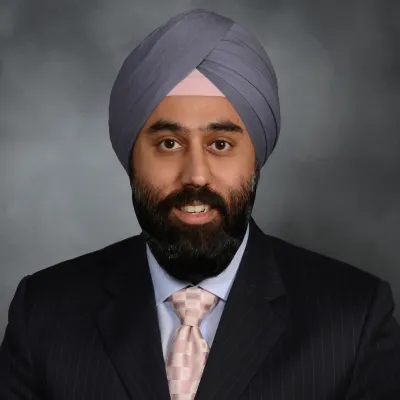At Och Spine at NewYork-Presbyterian and Weill Cornell Medicine, physicians are blending ancient Eastern wisdom with modern medicine to treat patients with low back pain. Recognizing the positive impact that mind-body practices tai chi and qigong have on their patients, Roger Härtl, MD, founder and neurosurgical director at Och Spine at NewYork-Presbyterian and Weill Cornell Medicine, and Jaspal Ricky Singh, MD, director of interventional spine and co-director of the Center for Comprehensive Spine Care at NewYork-Presbyterian and Weill Cornell Medicine, collaborated on the development of an innovative virtually delivered tai chi, qigong, and meditation (VDTQM) program for low back pain with Grandmaster Yang Yang, PhD, from the Center for Taiji and Qigong Studies.
Below, Dr. Härtl and Dr. Singh discuss the results of a randomized clinical study that investigated the effects of the integrated mind-body program on adults with low back pain. The results underscore the program’s potential in helping patients manage low back pain, improve physical function, and enhance wellbeing.
At Och Spine at NewYork-Presbyterian and Weill Cornell Medicine, we understood early on that if you really want to provide meaningful and successful care to patients with back problems, you have to focus on non-operative care. As surgeons, this is important because most patients don't need surgery, and if they don't need surgery, you still want to make sure that they have a great outcome.
— Dr. Härtl
Non-Operative Approaches to Meaningful and Successful Spine Care
Dr. Härtl: At Och Spine at NewYork-Presbyterian and Weill Cornell Medicine, we understood early on that if you really want to provide meaningful and successful care to patients with back problems, you have to focus on non-operative care. As surgeons, this is important because most patients don't need surgery, and if they don't need surgery, you still want to make sure that they have a great outcome.
There is increasing evidence that treatments focusing on body movement and mental retraining can reduce pain and improve disability in individuals with low back pain. About 15 years ago, Master Yang Yang approached us with an integrated tai chi and qigong class for patients and employees at NewYork-Presbyterian, which was very well received. After the COVID-19 pandemic began, we worked on developing an online version of the program.

Master Yang leading an integrated tai chi and qigong class for patients and employees at NewYork-Presbyterian.
The Mind-Body Benefits of Tai Chi and Qigong
Dr. Singh: What’s interesting about this specific type of mind, body, and motion program is that it is so spine correlated. First and foremost, the benefits of tai chi and qigong are on posture and spine alignment. At NewYork-Presbyterian and Weill Cornell Medicine, 70 -80% of the patients we see can stave off interventions such as injections, medications, or surgery just by improving their posture and alignment. Another important benefit is flexibility because these movements alleviate some of the tension around the back and neck. The third benefit is core muscle strengthening, which is important to take pressure off of spinal discs and prevent disc degeneration. Finally, many patients with mobility issues or who have a degenerative spine condition have concurrent hip, knee, or shoulder arthritis. Doing something that involves little to no impact on the spine or joints while improving circulation and blood flow seems like a win-win.
Tai chi and qigong also involve stillness, which requires isometric contractions of the muscles around the discs without putting too much stress on tendons. The mental benefit of stillness is relaxation and stress reduction. We believe there is little understanding about how much stress, tension, and other mental aspects can contribute to tightness around the spine.
Dr. Härtl: Stillness is a really important concept in the degenerative spine world, because so much of what we deal with when we see patients with neck and back pain concerns psychology. As a surgeon, one of the biggest challenges is figuring out how much of a patient’s pain is based on a physical problem in the spine that we can fix surgically versus how much is a reaction to a problem in the patient's mind. Stillness is a very important aspect of the philosophy of stoicism, in which one tries to control one’s reaction to something that is out of their control.
Research Methods
Dr. Härtl: This prospective randomized controlled trial compared 175 adult patients with low back pain enrolled in our VDTQM program to a control group of 175 waitlisted adult patients. The treatment group received a 12-week VDTQM program in live, online, 60-minute group classes twice a week from September-December 2022. Outcome measures were collected electronically from both groups at baseline, eight weeks, 12 weeks (at the conclusion of the treatment), and 16 weeks (four weeks after the conclusion of the treatment). The primary outcome measure for our study was improvement in pain-related disability assessed by the Oswestry Disability Index (ODI) score. Secondary outcomes included improvements in sleep quality, pain intensity, and quality of life.
Key Findings
Dr. Härtl: We found that patients who attended the 12-week online classes experienced statistically significant improvements in all of the measures compared to the control group. Patients participating in the program reported less pain, improved movement, better sleep, and an enhanced quality of life. These improvements persisted one month after the treatment concluded.
Last year, we saw 35,000 patients at Och Spine at NewYork-Presbyterian and Weill Cornell Medicine. The vast majority of these patients would benefit from a non-interventional, conservative treatment such as this program.
— Dr. Jaspal Singh
Study Implications
Dr. Singh: Last year, in 2023, we saw 35,000 patients at Och Spine at NewYork-Presbyterian and Weill Cornell Medicine. The vast majority of these patients would benefit from a non-interventional, conservative treatment such as this program. As we like to tell our patients, movement is medicine. You need to keep your body active, feed the blood flow, and get rid of the lactic acid and the toxins that build up with static energy. The best way to bring oxygen to your discs and your joints is through some type of motion.
Next Steps
Dr. Härtl: We are working on developing a mobile app to bring this virtual program to our patients. We’d love to offer this program to our post-operative patients, as it would be a great adjunct to post-surgical recovery. In the future, we hope to conduct research that compares a group of patients who undergo routine spinal surgery to another group that has the surgery plus this post-operative intervention.
Dr. Singh: Using data from this study, we just completed a study that explores the qualitative impact of the VDTQM program on patients, such as how their quality of life improved as a result of this intervention.
Collaborative Spine Care at Och Spine
Dr. Härtl: What is so great about at Och Spine at NewYork-Presbyterian and Weill Cornell Medicine is that all of the relevant subspecialists in spine care collaborate on the diagnosis, treatment, and management of back and neck disorders. This collaborative approach, combined with our expertise and the vast volume of patients we treat, allows us to provide the best care to our patients. It also allows us to recruit patients for studies such as this and disseminate information to our patients about the latest innovations in spine care.
Dr. Singh: If we didn't have a philosophy that was built upon interdisciplinary care, then a lot of integrative service providers, such as chiropractors, psychologists, pain management, and acupuncturists, wouldn’t even approach us to work with us. This speaks to how we approach spine care, and it's a lot more than epidurals and surgery.





